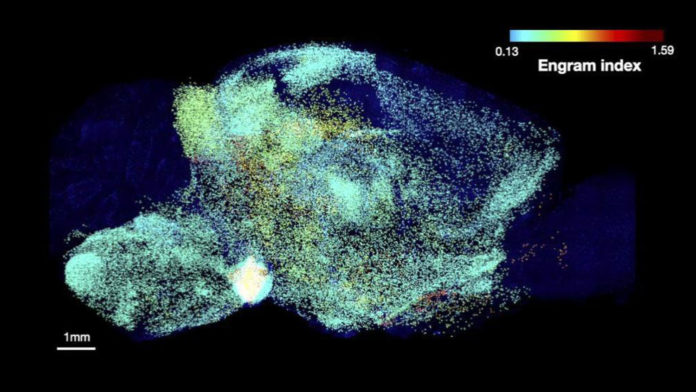A collection of neurons that holds specific memory have been identified in the hippocampus, amygdala, or cortex. However, it has been theorized that engrams of a particular memory are distributed among multiple brain regions that are functionally connected, referred to as a unified engram complex.
A new study by the scientists at The Picower Institute for Learning and Memory at MIT offers evidence that the brain does not store a single memory in just one or few regions. Instead, it stores memory across widely distributed, functionally connected complex spanning many brain regions. The study reflects the most comprehensive description of memory encoding cells or memory engrams.
Scientists identified several brain areas that were not previously known to be involved in memory. They showed that reactivation of multiple memory-storing regions causes powerful memory recall.
By analyzing more than 247 brain regions in mice, scientists mapped regions participating in an engram complex. These mice were taken from their home cage to another cage, where they felt a small but memorable electrical zap.
Neurons of one group of mice had been engineered to become fluorescent when they expressed a gene required for memory encoding. In another group, cells are activated by naturally recalling the zap memory. Scientists observed these activated cells (by memory encoding or by recall) under a microscope after the brains were preserved and optically cleared using a technology called SHIELD. After counting fluorescing cells in each sample using a computer, scientists created a brain-wide map of regions with apparently significant memory encoding or recall activity.
The maps show several regions that are associated with memory storage. To determine the areas that might get activated by activity unrelated to the zap memory, they compared what they saw in zap-encoding or zap-recalling mice to what they saw in the brains of controls left in their home cage.
Doing so allowed them to calculate an “engram index” to rank order 117 brain regions with a significant likelihood of being involved in the memory engram complex. They deepened the analysis by engineering new mice in which neurons involved in memory encoding and recall could be doubly labeled, revealing which cells exhibited overlap of those activities.
Scientists noted, “To be an engram cell, a neuron should be activated in encoding and recall. These experiments revealed significant engram reactivation in known hippocampal and amygdala regions and showed reactivation in many thalamic, cortical, midbrain, and brainstem structures. Importantly when we compared the brain regions identified by the engram index analysis with these reactivated regions, we observed that ~60 percent of the regions were consistent between analyses.”
Having ranked regions significantly likely to be involved in the engram complex, the team engaged in several manipulations to test their predictions and determine how engram complex regions might work together.
For instance, scientists engineered mice so that flashes of light can control cell activation by memory encoding. Later, they selected brain regions from their engram index list by applying light flashes. They observed if stimulating those would synthetically trigger the fear memory behavior of freezing in place, even when mice were placed in a “neutral” cage where the zap had not occurred.
Scientists noted, “Strikingly, all these brain regions induced robust memory recall when optogenetically stimulated. Moreover, stimulating areas that their analysis suggested were insignificant to zap memory indeed produced no freezing behavior.”
Scientists next identified connections between the different regions within an engram. They choose two known memory regions: CA1 of the hippocampus and the basolateral amygdala (BLA). By optogenetically activating engram cells, they induced memory recall behavior in a neutral cage.
They found that stimulating those regions produced memory recall activity in specific “downstream” areas identified as probable members of the engram complex. It means optogenetically inhibiting natural zap memory recall in CA1 or the BLA, associated with reduced activity in downstream engram complex areas compared to what they measured in mice with unhindered natural recall.
Further experiments showed that optogenetic reactivations of engram complex neurons followed similar patterns as those observed in natural memory recall. So having established that natural memory encoding and recall appears to occur across a wide engram complex, scientists next determined whether reactivation of multiple regions improves memory recall compared to reactivating just one. To do so, they used a chemical means to stimulate different engram complex regions. They found that stimulating up to three involved regions simultaneously produced more robust freezing behavior than stimulating just one or two.
Co-lead and co-corresponding author Dheeraj Roy said, “By storing a single memory across such a widespread complex, the brain might be making memory more efficient and resilient. Different memory engrams may allow us to recreate memories more efficiently when trying to remember a previous event (and similarly for the initial encoding where different engrams may contribute different information from the original experience). Secondly, in disease states, in a few regions are impaired, distributed memories would allow us to remember previous events and in some ways be more robust against regional damages.”
“In the long term, that second idea might suggest a clinical strategy for dealing with memory impairment: If some memory impairments are because of hippocampal or cortical dysfunction, could we target understudied engram cells in other regions, and could such a manipulation restore some memory functions?”
Journal Reference:
- Roy, D.S., Park, YG., Kim, M.E. et al. Brain-wide mapping reveals that engrams for a single memory are distributed across multiple brain regions. Nat Commun 13, 1799 (2022). DOI: 10.1038/s41467-022-29384-4
